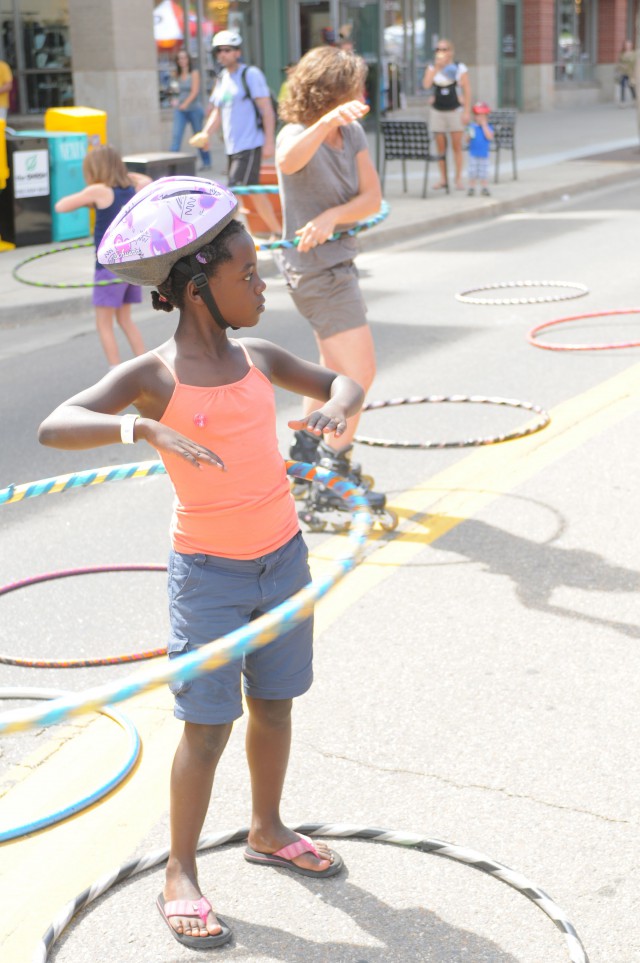
City planners across the world are struggling to imagine a new paradigm where city streets are not just avenues for gas-guzzlers, but places where people gather, where community is fostered and where the use of cars is actually minimal.
Called “placemaking,” or sometimes “reclamation,” the movement to reimagine what city streets can be is a quiet one in Boulder.
The average pedestrian might not realize how wide Boulder’s sidewalks tend to be, and drivers might be annoyed at the barriers in the Goss Grove neighborhood that make 21st Street an impassable shortcut from Arapahoe Avenue to Canyon Boulevard. Yet pedestrians risk accidents in places with narrow or nonexistent sidewalks, and neighborhoods without barriers may deal with speeding cars, constant traffic noise and decreased walkability.
On Sunday, Sept. 14, the placemaking movement in Boulder is going to be a bit louder than normal when Boulder Green Streets hosts its fifth annual Ciclovia, which Founder and Director Hillary Griffith equates to a “large-scale pattern interrupt” for the entire city.
About 20,000 people will reclaim roughly two miles of car-less streets for biking, walking and playing for the free event. From the Pearl Street Mall to the North Boulder Recreation Center, there will be a string of stations and venues where Ciclovians can cycle, learn new crafts like cheese-making and imagine a city where people take precedence over cars.
Ciclovia happens in cities across the world, especially in the Latino world where the biggest Ciclovia in Bogota, Colombia shuts down roughly 75 miles of roads every Sunday and draws as many as 1.5 million people. While that scale is exceptional, Boulder City Planner Sam Assefa says small U.S. cities like Boulder should not stop looking internationally for examples of city reclamation and placemaking.
“People like Hillary who introduced Ciclovia [to Boulder] are looking to open our streets up as places to celebrate culture, rather than looking at streets only for vehicular transportation,” says Assefa. “Having this discussion will eventually get people to change how they think about streets.”
Boulder City Councilman Macon Cowles says he thinks change needs to happen.
“We have too much expensive infrastructure dedicated to cars,” he says.
“Roads,
bridges, ramps, parking spaces and the very spacing between buildings.
All this infrastructure incents most people to take the car most of the
time.”
Cowles says the
key to change is for Boulder to cross the “15 percent threshold.” In
Europe, the experience is that once 15 percent of all trips are taken by
bicycle, then bicycle travel expands rapidly from there, he says.
Boulder is currently at 12 percent bike commuting for all trips,
according to Cowles.
Assefa reminds us, though, that change is slow.
“There was a lot of debate and resistance when the Pearl Street Mall was going to be closed to cars,” he says.
Business
owners especially worried that they would see a decline in revenue.
These days, the Pearl Street Mall is one of the highest valued
properties in the city.
Cowles
says the only reason takeovers like Ciclovia aren’t happening more
often in Boulder is that “not enough of us are working to make it
happen.”
For her part, Griffith seems to work tirelessly, seeing value in impermanent and quirky placemaking strategies.
“I
got excited by the kind of innovation used in Colombia,” she says and
references former Bogota mayor Antanas Mockus and how, in 1993, he
instituted the use of mimes as traffic controllers. They made fun of
traffic violators and, over time, were credited with having a
significant impact on the reduction of traffic accidents and making the
city safer for pedestrians.
The
International Review of Cycling Interventions claims that Ciclovia
events are “associated with more utilitarian cycling” and the American Journal of Public Health claims that “Ciclovias have been shown to be programmatic interventions that can promote cycling across a population.”
“As advanced as Boulder is, we are still not there.
We are still behind most places,” says Assefa. “If we compare ourselves to U.S. cities, we are pretty much at the top.”
Yet
Boulder is behind international cities not just for biking (in
Copenhagen, 37 percent of commuters use bikes to get to work or school)
but for inclusion, as well. Griffith says she sees people every year at
Ciclovia who have never ridden a bicycle, but in Boulder they get
overlooked because everyone assumes everyone is a cyclist.
She says she hopes Boulder’s Ciclovia can help non-cyclists come out of the woodwork and embrace cycling.
On
the cultural diversity front, Assefa says it is likely Ciclovia could
help diversify Boulder and give the city what it currently lacks: a
public space where different cultural and socioeconomic backgrounds can
meet as equals.
“Where
we haven’t done well is in making the use of public space affordable,”
he says. “How do we make a place where diverse groups and incomes feel
comfortable? For example, we have a large number of Latinos who live
here, but you don’t normally see them at things like Ciclovia.”
Boulder
Green Streets has partnered this year with the Americas Latino
Eco-Festival, the Latino-hosted festival for environmental leaders in
Boulder geared toward increasing the presence of the Latino population
in the environmental movement, and there will be a Zona Latina.
Griffith
says her goal is to foster that space where people from different
ethnic and socioeconomic backgrounds meet as equals. Subsequent gradual
changes might make Boulder’s Ciclovia something a bit revolutionary —
like free public health clinics — where different cultures, ages and
pocketbooks can mingle, she adds.
She encourages people to help out by being vocal.
“How
we run this event is not coming from the top down,” she says. “If
enough people advocate for it, we can go to City Council with that, and
say, ‘This is what people want.’” Assefa concurs. He says, “We can learn
from other places, but it is also more important to have our own unique
approach grounded in the values of our citizens.”
Respond: [email protected]














